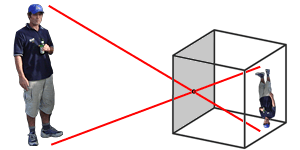Pinhole Cameras
A pinhole camera consists of a box or other container with a tiny hole through which light enters. The image is captured on a recording medium at the back of the box (the rear plane). The general principle is exactly the same as any other type of camera except there is no lens, just a hole.

Build Your Own Pinhole Camera
Container
The container must be completely light-tight, i.e. absolutely no light can get in anywhere except the pinhole. You might want to use a black plastic wrap to enclose the container.
Hole
Smaller holes generally produce clearer images, although a hole that is too small can become less clear due to diffraction effects. The size of the hole should be no bigger than 1/100th the distance to the rear plane.
The hole should be perfectly round, preferably in a very thin material. You might like to cut a larger hole in the container and fill it with a thinner material in which you make the actual pinhole. Here is a common approach:
- Cut a piece of aluminium from a drinks can.
- Use fine sandpaper to wear down an area in the middle of the aluminium so it is very thin.
- Create the pinhole with a small needle. Rotate the needle as it goes in and out to create a more circular hole.
- Sand away any burrs from around the hole.
Rear Plane
The rear plane is where the image is captured either by film or a digital CCD device. In some cases the image may not be captured at all; instead the rear plane is a translucent screen that allows the image to be viewed in real time (viewing a solar eclipse is an example of how this could be useful).
Moving the rear plane closer to the pinhole will result in a wider angle field of view and shorter exposure time. Moving the rear plane away from the pinhole will result in a narrower angle view and a longer exposure time.
Shutter
The "shutter" is usually a hand-operated device, e.g. a light-tight cover that is removed and replaced by the photographer.
Focus & Exposure
Depth of field is effectively infinite so you don't need to worry about focusing on a particular subject. You just need to make sure the image itself is focused and everything should be okay.
Pinhole photographs require longer exposure time than normal cameras. This can be anything from a few seconds to a few hours or even days.
To calculate the f-stop, divide the focal length by the pinhole diameter, e.g.:
Focal length (40mm) / Pinhole diameter (0.4mm) = f-stop (100)